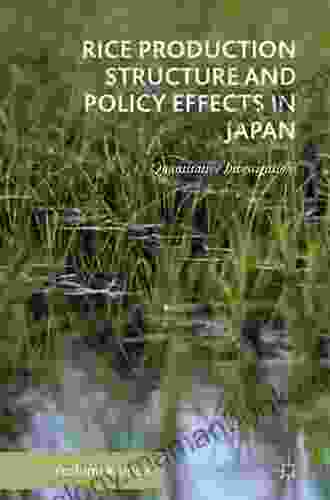Rice Production Structure and Policy Effects in Japan: A Comprehensive Analysis

Rice is a staple food in Japan, and its production has been closely intertwined with the country's history, culture, and economy. In this article, we delve into the structure of rice production in Japan, examining factors such as farm size, yields, and government subsidies. We also analyze the effects of these factors on production costs, market prices, and consumer welfare.
4.8 out of 5
| Language | : | English |
| File size | : | 4024 KB |
| Text-to-Speech | : | Enabled |
| Screen Reader | : | Supported |
| Enhanced typesetting | : | Enabled |
| Word Wise | : | Enabled |
| Print length | : | 239 pages |
Farm Size and Production Structure
Japan's rice production is characterized by a large number of small-scale farmers. According to the Ministry of Agriculture, Forestry and Fisheries (MAFF),there were over 1.3 million rice farmers in Japan in 2020, with an average farm size of just 1.5 hectares. This fragmented structure poses challenges for mechanization and efficient production.
The small farm size is a result of historical factors, including land inheritance laws and government policies that have encouraged small-scale farming. While small farms may provide employment and social stability, they also face challenges in terms of profitability and sustainability.
Yields and Production Trends
Despite the small farm size, Japan has achieved high rice yields through technological advancements and government support. The average rice yield in Japan in 2020 was 5.5 tons per hectare, which is higher than the global average of 3.9 tons per hectare. This high yield is due to factors such as improved crop varieties, advanced irrigation systems, and government subsidies for fertilizers and other inputs.
Rice production in Japan has remained relatively stable in recent years, with annual production fluctuating around 8 million tons. However, there has been a slight downward trend in production due to factors such as decreasing demand, rising production costs, and an aging farming population.
Government Subsidies and Policy Effects
The Japanese government plays a significant role in supporting rice production through a variety of subsidies and policies. These include:
- Price supports: The government sets a minimum price for rice, which is higher than the market price. This provides farmers with a guaranteed income, even during years of low market prices.
- Direct payments: The government provides direct payments to farmers based on their production area and yield. These payments help to supplement farmers' incomes and cover production costs.
- Subsidies for inputs: The government provides subsidies for fertilizers, pesticides, and other inputs used in rice production. These subsidies help to reduce farmers' production costs.
- Land consolidation programs: The government encourages farmers to consolidate their fragmented landholdings to create larger, more efficient farms. This has the potential to increase yields and reduce production costs.
These government subsidies and policies have had a significant impact on rice production in Japan. They have helped to stabilize prices, support farmers' incomes, and increase yields. However, they have also led to higher production costs and a distortion of the market.
Production Costs and Market Prices
The production costs of rice in Japan are relatively high due to factors such as the small farm size, high labor costs, and government subsidies for inputs. The average production cost per kilogram of rice in 2020 was estimated to be around 150 yen (approximately $1.35). This is significantly higher than the market price of rice, which is typically around 100 yen (approximately $0.90) per kilogram.
The high production costs are a major challenge for Japanese rice farmers. They make it difficult for farmers to compete with imported rice from countries with lower production costs. As a result, the Japanese government maintains high import tariffs on rice to protect domestic farmers.
Consumer Welfare and Policy Implications
The government's rice production policies have a significant impact on consumer welfare. The high production costs and import tariffs result in higher rice prices for consumers. This can be a burden on low-income households and consumers who rely on rice as a staple food.
In addition, the government's support for small-scale farming can lead to inefficiencies in production. This can result in higher prices for consumers and lower incomes for farmers. Therefore, it is important to find ways to balance the support for small-scale farming with the need for efficient and sustainable rice production.
Rice production in Japan is a complex issue that involves factors such as farm size, yields, government subsidies, production costs, market prices, and consumer welfare. The government's policies have had a significant impact on rice production in Japan, but there are also challenges that need to be addressed. By carefully considering the trade-offs and implications of different policies, it is possible to create a rice production system that supports farmers, consumers, and the overall economy.
4.8 out of 5
| Language | : | English |
| File size | : | 4024 KB |
| Text-to-Speech | : | Enabled |
| Screen Reader | : | Supported |
| Enhanced typesetting | : | Enabled |
| Word Wise | : | Enabled |
| Print length | : | 239 pages |
Do you want to contribute by writing guest posts on this blog?
Please contact us and send us a resume of previous articles that you have written.
 Top Book
Top Book Novel
Novel Fiction
Fiction Nonfiction
Nonfiction Literature
Literature Paperback
Paperback Hardcover
Hardcover E-book
E-book Audiobook
Audiobook Bestseller
Bestseller Classic
Classic Mystery
Mystery Thriller
Thriller Romance
Romance Fantasy
Fantasy Science Fiction
Science Fiction Biography
Biography Memoir
Memoir Autobiography
Autobiography Poetry
Poetry Drama
Drama Historical Fiction
Historical Fiction Self-help
Self-help Young Adult
Young Adult Childrens Books
Childrens Books Graphic Novel
Graphic Novel Anthology
Anthology Series
Series Encyclopedia
Encyclopedia Reference
Reference Guidebook
Guidebook Textbook
Textbook Workbook
Workbook Journal
Journal Diary
Diary Manuscript
Manuscript Folio
Folio Pulp Fiction
Pulp Fiction Short Stories
Short Stories Fairy Tales
Fairy Tales Fables
Fables Mythology
Mythology Philosophy
Philosophy Religion
Religion Spirituality
Spirituality Essays
Essays Critique
Critique Commentary
Commentary Glossary
Glossary Bibliography
Bibliography Index
Index Table of Contents
Table of Contents Preface
Preface Introduction
Introduction Foreword
Foreword Afterword
Afterword Appendices
Appendices Annotations
Annotations Footnotes
Footnotes Epilogue
Epilogue Prologue
Prologue Deborah Hale
Deborah Hale Kate Haxell
Kate Haxell Chanel Miller
Chanel Miller Guillaume Olive
Guillaume Olive Barry Maz
Barry Maz Lynne Truss
Lynne Truss Heather Slade
Heather Slade Krishna S Mercy
Krishna S Mercy Marguerite Kaye
Marguerite Kaye Jack Carr
Jack Carr Sally Spencer
Sally Spencer T Kingfisher
T Kingfisher Anni K Reinking
Anni K Reinking Michelle Rousseau Suzanne Rousseau
Michelle Rousseau Suzanne Rousseau Clare Flynn
Clare Flynn Randy Wayne White
Randy Wayne White Williamson Murray
Williamson Murray Fiona Danks
Fiona Danks Dee Ann Waite
Dee Ann Waite Janine Marsh
Janine Marsh
Light bulbAdvertise smarter! Our strategic ad space ensures maximum exposure. Reserve your spot today!

 Eliot FosterWhat Every Athlete and Parent Should Know About the Prevention and Treatment...
Eliot FosterWhat Every Athlete and Parent Should Know About the Prevention and Treatment...
 Mario Vargas LlosaThe Extraordinary Story of the Atomic Bomb and the 116 Days that Changed the...
Mario Vargas LlosaThe Extraordinary Story of the Atomic Bomb and the 116 Days that Changed the... Alexandre DumasFollow ·10k
Alexandre DumasFollow ·10k Robert BrowningFollow ·13.5k
Robert BrowningFollow ·13.5k William GoldingFollow ·11.3k
William GoldingFollow ·11.3k Guy PowellFollow ·19.2k
Guy PowellFollow ·19.2k Glen PowellFollow ·9.1k
Glen PowellFollow ·9.1k Alvin BellFollow ·7k
Alvin BellFollow ·7k Peter CarterFollow ·17.3k
Peter CarterFollow ·17.3k Ashton ReedFollow ·8.3k
Ashton ReedFollow ·8.3k

 Christopher Woods
Christopher WoodsDeath's Second Chance: The Unbelievable Story of Cris...
On July 29, 2008, Cris...

 Esteban Cox
Esteban CoxFrom Ralphie Kids to Adolescents: The Journey to Manhood
The transition from...

 Chris Coleman
Chris ColemanLetters From Young Father Poems: Delving into the Heart...
Fatherhood, a journey filled...

 Holden Bell
Holden BellCounterintuitive Marketing: Achieving Great Results Using...
In the ever-evolving world of...
4.8 out of 5
| Language | : | English |
| File size | : | 4024 KB |
| Text-to-Speech | : | Enabled |
| Screen Reader | : | Supported |
| Enhanced typesetting | : | Enabled |
| Word Wise | : | Enabled |
| Print length | : | 239 pages |












